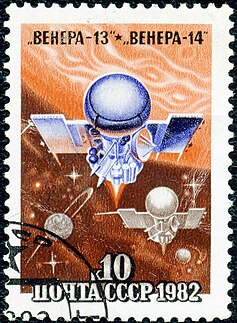
Venera 13 was a probe in the Soviet Venera program for the exploration of Venus.

Maxwell Montes is a mountain massif on the planet Venus, of which a peak is the highest point on the planet's surface.

Venus is a planet with striking geology. Of all the other planets in the Solar System, it is the one nearest to Earth and most like it in terms of mass, but has no magnetic field or recognizable plate tectonic system. Much of the ground surface is exposed volcanic bedrock, some with thin and patchy layers of soil covering, in marked contrast with Earth, the Moon, and Mars. Some impact craters are present, but Venus is similar to Earth in that there are fewer craters than on the other rocky planets that are largely covered by them.
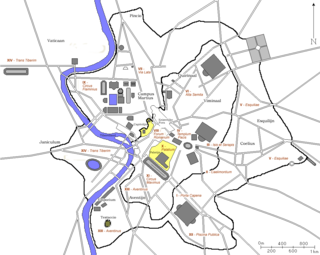
In 7 BC, Augustus divided the city of Rome into 14 administrative regions. These replaced the four regiones — or "quarters" — traditionally attributed to Servius Tullius, sixth king of Rome. They were further divided into official neighborhoods.

Aphrodite Terra is one of the three continental regions on the planet Venus, the others being Ishtar Terra and Lada Terra. It is named for Aphrodite, the Greek equivalent of the goddess Venus, and is found near the equator of the planet. Aphrodite Terra is about half the size of Africa, making it the largest of the terrae.

Alpha Regio is a region of the planet Venus extending for about 1500 kilometers centered at 22°S, 5°E.
Beta Regio is a region of the planet Venus known as a volcanic rise. Measuring about 3,000 kilometres in extent, it constitutes a prominent upland region of Venus centered at 25.3°N 282.8°E.

Sapas Mons is a large volcano located in the Atla Regio region of Venus.
Regio is the Latin word for ‘region’ and the Italian word for ‘royal’
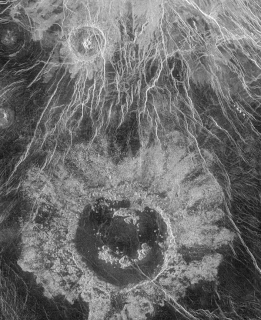
Wheatley is a crater on Venus at latitude 16.6, longitude 268 in Asteria Regio. It is 74.8 km in diameter and was named after Phillis Wheatley, the first black writer of note in America (1753-1784).
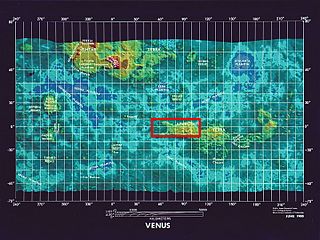
Ovda Regio is a Venusian crustal plateau located near the equator in the western highland region of Aphrodite Terra that stretches from 10°N to 15°S and 50°E to 110°E. Known as the largest crustal plateau in Venus, the regio covers an area of approximately 15,000,000 square kilometres (5,800,000 sq mi) and is bounded by regional plains to the north, Salus Tessera to the west, Thetis Regio to the east, and Kuanja as well as Ix Chel chasmata to the south. The crustal plateau serves as a place to hold the localized tessera terrains in the planet, which makes up roughly 8% of Venus' surface area. The kinematic evolution of crustal plateaus on Venus has been a debated topic in the planetary science community. Understanding its complex evolution is expected to contribute to a better knowledge of the geodynamic history of Venus. It is named after a Marijian forest spirit that can appear as both male and female.
In 1758, in the 10th edition of Systema Naturae, the Swedish scientist and taxonomist Carl Linnaeus described the class "Vermes" as:
Animals of slow motion, soft substance, able to increase their bulk and restore parts which have been destroyed, extremely tenacious of life, and the inhabitants of moist places. Many of them are without a distinct head, and most of them without feet. They are principally distinguished by their tentacles. By the Ancients they were not improperly called imperfect animals, as being destitute of ears, nose, head, eyes and legs; and are therefore totally distinct from Insects.

Guinevere Planitia is an expansive lowland region of Venus that lies east of Beta Regio and west of Eistla Regio. These low-lying plains, particularly in the western portion, are characterized by apparent volcanic source vents and broad regions of bright, dark, and mottled deposits. They are the only break in an equatorially connected zone of highlands and tectonic zones. The types, numbers, and patterns of mapped tectonic features and small volcanic landforms in the region provide important detail in the interpretation and evolution of venusian landscape.

Irnini Mons is a volcanic structure on the planet Venus, and is named after the Assyro-Babylonian goddess of cedar-tree mountains. It has a diameter of 475 km (295 mi), a height of 1.75 km (1.09 mi), and is located in Venus' northern hemisphere. More specifically, it is located in the central Eistla Regio region at in the V-20 quadrangle. Sappho Patera, a 225 km (140 mi) diameter wide, caldera-like, depression tops the summit of Irnini Mons. The primary structural features surrounding Irnini Mons are graben, seen as linear depressed sections of rock, radiating from the central magma chamber. Also, concentric, circular ridges and graben outline the Sappho Patera depression at the summit. The volcano is crossed by various rift zones, including the north-south trending Badb Linea rift, the Guor Linea rift extending to the northwest, and the Virtus Linea rift continuing to the southeast.

Devana Chasma is a weak extensional rift zone on Venus, with a length of 4000 km, a width of 150–250 km, and a depth reaching 5 km. Most of the faults are facing north–south. The rift is located in Beta Regio, a 3000 km rise created by volcanic activity. Mantle plumes rising from the bottom are the reason behind the formation of the rift zone. The slow extension rates in the rift may be driven by the same reason.

Ganis Chasma is a group of rift zones on the surface of the planet Venus. Bright spots detected by the Venus Monitoring Camera on the European Space Agency's Venus Express in the area suggest that there may be active volcanism on Venus.

The surface of Venus is dominated by geologic features that include volcanoes, large impact craters, and aeolian erosion and sedimentation landforms. Venus has a topography reflecting its single, strong crustal plate, with a unimodal elevation distribution that preserves geologic structures for long periods of time. Studies of the Venusian surface are based on imaging, radar, and altimetry data collected from several exploratory space probes, particularly Magellan, since 1961. Despite its similarities to Earth in size, mass, density, and possibly composition, Venus has a unique geology that is unlike Earth's. Although much older than Earth's, the surface of Venus is relatively young compared to other terrestrial planets, possibly due to a global-scale resurfacing event that buried much of the previous rock record. Venus is believed to have approximately the same bulk elemental composition as Earth, due to the physical similarities, but the exact composition is unknown. The surface conditions on Venus are more extreme than on Earth, with temperatures ranging from 453 to 473 °C and pressures of 95 bar. Venus lacks water, which makes crustal rock stronger and helps preserve surface features. The features observed provide evidence for the geological processes at work. Twenty feature types have been categorized thus far. These classes include local features, such as craters, coronae, and undae, as well as regional-scale features, such as planitiae, plana, and tesserae.
Pioneer Terra is a region on the dwarf planet Pluto, north of Tombaugh Regio and east of Voyager Terra. It was discovered by the New Horizons spacecraft on 14 July 2015. It is named for the Pioneer program, which included Pioneer 10 and Pioneer 11, the first spacecraft to cross the asteroid belt and explore Jupiter and Saturn, as well as the first to explore the outer Solar System; Pioneer 6, 7, 8, and 9, which formed an "interplanetary weather network"; Pioneer 1 through 5, which explored the Moon in various ways; and the Pioneer Venus project, consisting of a probe and orbiter to Venus.
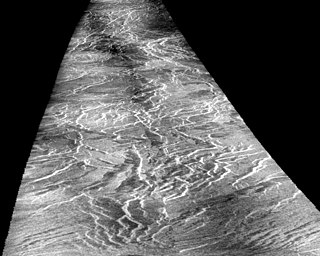
Phoebe Regio is a regio on the planet Venus. It lies to the southeast of Asteria Regio. It is 2,852 kilometres (1,772 mi) in diameter and is the principal feature of the V41 quadrangle, to which it gave its name. Four Soviet landers, Venera 11, Venera 12, Venera 13 and Venera 14, landed on the eastern side of Phoebe Regio and performed various scientific measurements.














